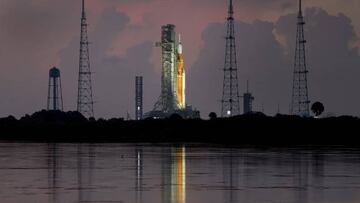Why is NASA returning to the moon after 50 years? A former agency administrator thinks it’s a mistake
The Artemis I rocket is due to launch this week but former NASA administrator Lori Garver believes the agency is treading over old ground.


Later this week NASA hopes to launch the first craft as part of the Artemis I mission which aims to return humans to the surface of the moon for the first time in 50 years. The launch date was set for Monday 29 August until technical difficulties forced officials to delay lift-off.
But why, after five decades on terra firma, is the space agency now trying to send people back to the moon?
The delayed launch is simply the first stage in the Artemis program, which hopes to see humans land on the unexplored lunar south pole for the very first time and eventually reach Mars. These long-duration deep space exploration missions are seen as a vital step in the agency’s effort to push the boundaries.
“We’re going back to the moon in order to learn to live, to work, to survive,” NASA administrator Bill Nelson explained in a recent press conference.
“How do you keep humans alive in those hostile conditions? And we’re going to learn how to use the resources on the moon in order to be able to build things in the future as we go - not a quarter of a million miles away, not a three-day journey - but millions and millions of miles away on a months and months if not years-long journey.”
Founding a staging post on the moon could be a crucial step for future missions, whether manned or unmanned, aiming to reach further into outer space. The Artemis program itself is collaborative project with international partners the European Space Agency (ESA), the Japanese Air Exploration Agency (JAXA), and the Canadian Space Agency (CSA).
Former NASA administrator questions the moon mission
While NASA claims that a return to the moon constitutes an important step towards future discoveries, not everyone is convinced of the program’s merits. NASA former deputy administrator Lori Garver has argued that the agency should be shifting its focus towards the issues facing the human race now, rather than using its enormous resources to repeat previous work.
Speaking in an interview with Scientific American, Garver outlines some of her concerns about NASA’s direction:
“I am conflicted. I want to embrace this point in history that so many people have worked for—to have the capability to again go to the moon.”
“Really, the question is: is Artemis a priority for this nation? Do we feel we must, as we felt during Apollo, get people on the moon in the next few years? And if we do, that current architecture requires a lot of things: SLS, Orion, Starship, eventually Gateway, the spacesuits. There are a lot of moving parts that need to come together, and it’s not clear to me what the long pole in the tent is at this point.”
RETURN TO THE MOON: The Artemis 1 mission is set to launch on Friday after Monday's mission was scrubbed. Former NASA deputy administrator @Lori_Garver joins @joefryer on #MorningNews Now with what the setback means for the Artemis program.
— NBC News NOW (@NBCNewsNow) August 30, 2022
Watch: https://t.co/U4UZMHn7bF pic.twitter.com/wYvCyceaPe
Related stories
But when asked what excites her most in space science currently, she was far more positive about the work that NASA is doing. She said:
“I am, as I have always been, excited about the search for life beyond Earth—so that includes Mars, Mars Sample Return, as well as extrasolar planets that we find first with Kepler and now the James Webb Space Telescope. I really bought into the big questions that we can learn through space science.”

